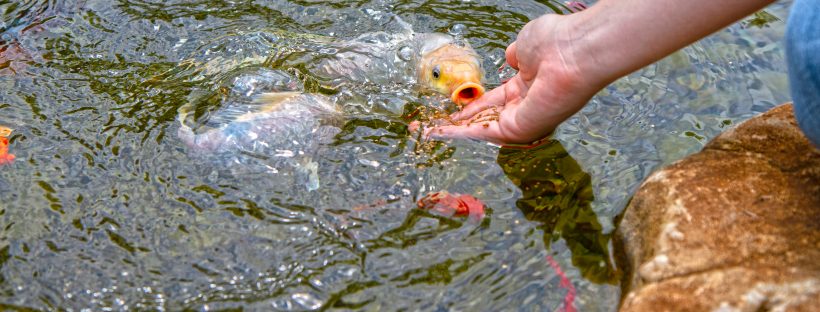
There are many good reasons to want to keep ornamental carp, known as koi fish. First and most of all, they are friendly, engaging creatures that will recognize and respond to you. It’s a great feeling to see a whole shoal of happy, HUNGRY jewel-colored fish churning the water to reach you. Yes they learn, quickly and well, to expect food, but they respond to you whether you have food for them or not, every time. It’s delightful.
They are very beautiful animals by any measure. Their colors are marvelous, with hues from the deepest reds through orange, true gold, silver, pearly white, black, greys of every shade, even blues. Many varieties sport glittering reflective and metallic scales, in different patterns on their bodies, that literally sparkle in sunlight. Their fins can be equally enchanting, especially those of the type commonly known as butterfly koi. When they aren’t racing to you for food, their long flowing fins swirl around them as they dance gracefully in a synchronized ballet, the rhythmic, circular patterns they describe soothing, relaxing, almost hypnotic. One can get lost for hours just staring at their languid movements in a deep, clear pool, I can personally assure you.

But to enjoy them at their best you must provide a healthy environment for them. The best koi ponds will ideally be large and deep enough for the fish to exercise in both horizontal and vertical directions; three feet is usually cited as the minimum depth for happy koi. The optimal volume per fish is harder to pin down, but experts and aficionados (koi kichi) like 100 gallons per inch of fish; bigger is always better as far as volume goes. That said, koi will adapt to smaller bodies of water, but they will not attain the same size and run the risk of greater mortality in smaller, shallow ponds for a number of reasons, including more exposure to predators and greater temperature and pH swings.
Water quality is critical, especially with animals that feed (and defecate) with such gusto. In Japan many ponds have a constant source of fresh spring water to flush out wastes, but that doesn’t work here, so adequate circulation and filtration is a must. Figure on running the entire volume of the pond through the filtration system once per hour. A 5,000 gallon pond should optimally run 5,000 gallons per hour through the filter. Although quality and clarity are totally different issues, with some of the best koi in the world coming out of clay ponds with totally opaque water, that doesn’t work for our ponds. We want to see the koi in polished water, so secondary treatment by ultraviolet light helps keep algae suppressed and water gin-clear.
Finally, for the healthiest, most vibrant koi, the pond shouldn’t be overcrowded. This is where we have to overcome our own nature, because koi keeping is a powerful addiction. We see an especially beautiful fish and we need to have it. Not only do we always want more of them, but they grow to a pretty impressive size. Forget the four-inch-long cutie you brought home from the pet store. Koi grow to 2-3 feet long and upwards of 30 pounds under ideal conditions, and if they’re happy, they are also procreating like crazy. If you’re not very careful and very disciplined, pretty soon you can walk across the pond on their backs.

All that said, once you get the bug you’ll never be free of it, so remember these guidelines.
- Build It Bigger! The one comment we hear from just about every customer after a couple of years is, we should have made the pond larger and deeper from the start.
- Oversize the filtration. The largest skimmer you can install reduces the frequency of emptying the net or basket. The larger the biofilter, the less often you will need to clean it. The less maintenance the happier you will be, and the more filtration, the cleaner and clearer the water. (Plus, you will be able to better support that greater-than-optimal number of fish that you will almost certainly end up with.)
- DON’T OVERFEED YOUR FISH, even if they beg, and they will! Too much food means too many nutrients in the water, overloading filtration and vastly complicating maintenance. Also, no matter how much they seem to want to eat, the last thing you want is obese, unhealthy fish. Feed them once a day as much as they can eat in 5 minutes, turning off the pumps to keep uneaten food from accumulating in the skimmer.
If you’re interested in koi keeping, Atlantic-OASE has everything you need, from kits that make pond construction easy, to advanced filtration that cleans itself and reports back to you via WiFi. You might start by checking out the information at the Atlantic Water Gardens University on our website, and remember, we’re always here to help. Good Luck, and Happy Ponding!
About the Author:

DEMI FORTUNA
Demi has been in water garden construction since 1986. As Atlantic’s Director of Product Information, if he’s not building water features, he’s writing or talking about them. If you have a design or construction question, he’s the one to ask.


